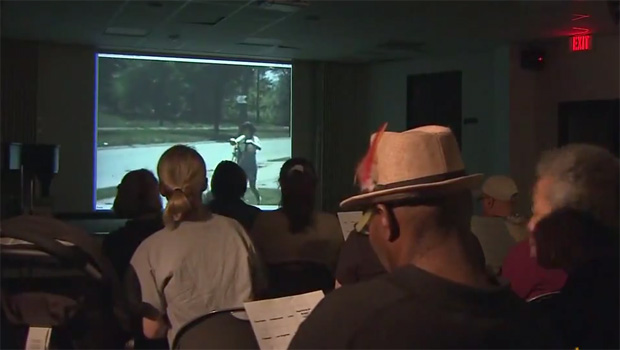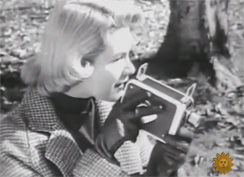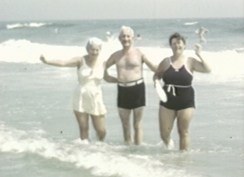Bringing the importance of home movies into focus
You needed a projector and screen to enjoy the home movies of an earlier time ... home movies that a modern-day movement is determined to preserve. David Turecamo has everything but the popcorn:
At the Durham County Library in North Carolina recently, there was event celebrating the movies. Not an awards show; it was a screening of home movies which some people might think date to the Stone Age.
"I haven't seen these in 30 years!" said one visitor.
People brought their movies to screen and have transferred to DVD. It was sponsored by the Center for Home Movies, a national organization dedicated to the preservation of, well, home movies.
"These are important cultural artifacts; we want to make sure that you're not throwing them away," said Skip Elsheimer, one of the directors of the Center for Home Movies.
"It's almost voyeuristic in a way to watch somebody else's home movies," he said. "But you get to see the common experiences; you get to see how somebody else celebrated Christmas, which is sometimes very different, or very much the same."
These days we're watching ourselves on YouTube and Facebook and documenting our lives at arm's length, so it's useful to remember that this digital obsession we have really began with home movies.
Kodak made home movies a central part of family life, just in time for the Baby Boom. You really couldn't afford not to shoot them, especially because it was so easy.
"Even if you've never snapped a picture before, you'll make exciting movies, indoors or out, with the new Brownie movie camera!"
The Brownie movie camera is the grandchild of the original Kodak camera, a Brownie for still photographs. That was the invention of George Eastman, who created Eastman Kodak. Beginning 130 years ago, when Eastman received his first patent, Kodak's slogan was, "You press the button, we do the rest."
"First of all, if the cameras made a successful image, you're going to use more film," said Todd Gustafson, the curator of technology at the George Eastman House in Rochester, N.Y. "So it really was the film business -- the cameras were the means to shoot film. Obviously they made money on the cameras, but the film was a lot more profitable."
George Eastman House, an international museum housing 16,000 cameras, projectors, editing and lighting equipment, "really archives the history of photography, soup to nuts," said Gustafson.
Today, George Eastman's house itself is a living biography of the man who invented the modern era of photography.
"Everyone looks at it and says, 'Oh, it's all antiques, it's all old stuff.' Eastman didn't like antiques or old stuff," said curator Cathy Connor. "Everything that you're looking at was what was brand new at the turn of the century. He had electric light; most people had gas light. There was a phone in each room. He had indoor plumbing. He was a scientist, an engineer, he was inventor."
Eastman's great invention, a simple camera and easy-to-use film, might never have happened -- except that as a young man he was working in a bank and heard it was possible to make money investing in some land in Santo Domingo. "It was a land rush; it was kind of a risky investment. It was suggested before he do this that he should document the land photographically."
Which meant he either had to learn how to take pictures himself, or pay for an artist to come with him, draw them and then sign his name, as proof that the property existed.
"Photography as we know it was a lot different," said Gustafson. "At that time, people were doing the wet plate process, where the photographer had to be both the photographer and the chemist."
"[Eastman] bought all the photographic equipment, his camera, his big tripod -- a lot of investment of money -- and then took lessons," said Connor.
He became more interested in photography than he was in investing in land, and set up shop in his mother's kitchen. He even cancelled his trip to Santa Domingo. "He never went, because he got so into photography and learning how to make it better and be better at it," said Connor. "He also mentioned many times that photography chemicals were bad traveling companions -- he spilled them on his underwear, his clothes, he ruined things when he was trying to pack them. So he wanted to find a way of making photography easier. And that's how he got into the photography business."
Eventually Eastman was approached by Thomas Edison to create film for motion pictures -- 35mm film, which is still the industry standard. But Eastman wanted to take it a step further: to the consumer level.
Movie cameras like the kind used in Hollywood were big and expensive. The solution: the Cine-Kodak. This is where home movies began. Not even half the size of a professional camera, it used the even smaller 16mm film introduced in 1923. It may look primitive, but it began a revolution.
And even today the camera still works, as Turecamo demonstrated with film he shot in Central Park.
The biggest drawback was the retail price -- the equivalent of about $2,000. So in 1926 Kodak introduced the Model B. Instead of hand-cranked, it was spring-wound. "So you just flip the lever and it runs, you don't have to worry about the right speeds."
For the first time ever a family could shoot a record of their day at the beach.
Color film didn't come in until the 1930s. Footage of Eastman with Thomas Edison was an early experiment.
And while home movies are great memories for a family, they are also a time capsule. (Look at those cars!) It's one reason the Center for Home Movies has sponsored more than 100 events like Home Movie Day all over the world in hopes people will recognize what they have boxed away in their closets.
"Traditionally, people think that home movies are boring, but they show us Main Street USA and how much it's changed," said Skip Elsheimer. "Because they actually show how we used to live. It's a cultural history."
For more info:
- Center for Home Movies
- Home Movie Day, October 17, 2015; Find a Home Movie Day event near you
- Caring for your home movies
- George Eastman House/International Museum of Photography and Film, Rochester, N.Y.
- Durham County Library, Durham, N.C.
- Home Movies Collection at the Internet Archive (archive.org)
- littlefilm.org (for lovers of 16mm, 8mm, Super 8 and 9.5mm films)


